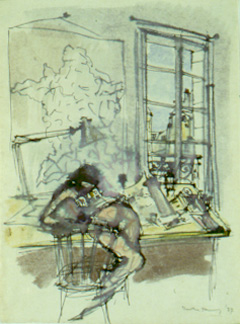![]()
Departments
Arts
![]()

|
Week of 26 February 1999 |
Vol. II, No. 25 |
Arts
|
|
|
|
|
Soprano Deborah van Renterghem, a second-year student in SFA's Opera Institute, stars in Dido's Lament, adapted by Drew Minter from Purcell's Dido and Aeneas. In Roman mythology, Dido, queen of Carthage, fell in love with Aeneas and killed herself when he abandoned her. The production is the fourth and final event of the 1998-99 Opera Fringe Festival, a celebration of one-act operas. Dido's Lament will be presented in SFA Studio 104 on Wednesday, March 3, at 3:30 and 8 p.m., and Thursday, March 4, at 5 and 8 p.m. Admission is $5, free for students. Photo by Kalman Zabarsky |
Dorothea Tanning pairs the painterly and the poetic
By J. Nicole Long
One of the pivotal paintings in the Boston University Art Gallery's exhibition of works by Dorothea Tanning is Still in the Studio. Its selection as part of the exhibition's title is apt: 20 years after she finished the piece, the 87-year-old Tanning is indeed still in her studio.
"Dorothea's work is underappreciated in Boston," says John Stomberg, director of the BU Art Gallery, where Dorothea Tanning: Still in the Studio will be held from March 5 through April 11. "I wanted a show that demonstrates how she continues to be a vital contributor to painting. When people know her, they usually know her for her early surrealist work."
The exhibition celebrates Tanning's latest suite of paintings, Another Language of Flowers, which depicts figures juxtaposed with rare flora that can't be ordered from a catalogue, but have emerged from Tanning's imagination.
As a patron of poets and member of the advisory board for the Academy of American Poets, Tanning asked 12 accomplished contemporary poets, including John Ashbury, Richard Wilbur, W. S. Merwin, and Associate University Professor Rosanna Warren, to write poems inspired by her work. For the exhibition, Stomberg has arranged for the poems to appear alongside the paintings in the gallery.
|
|
|
Study for Still in the Studio, 1977, shows
the preliminary stage of an oil painting Tanning
completed in 1979. The title of the finished piece,
Still in the Studio, describes threes aspect of the
painting -- a still life made up of paints, jars,
and brushes, the quiet and inactivity of her Paris
studio just before she returned to New York to
live, and the fact that she had not altogether left
her Paris studio -- part of her is still there. In
the final painting, an amorphous figure seems to
emanate from the figure like smoke, or like a genie
rising from a lantern. The painting that evolved
from the study marked a turning point in Tanning's
life and work and is featured in the exhibition at
the BU Art Gallery.
|
In a chronology of her life, 1977 is the turning point, Tanning writes. "1977 -- Grief begets hallucination. A crazily productive year; 1978 -- On the fence. (Paris? Seillans? New York?); 1980 -- Dorothea Tanning completes her return to the United States."
Tanning has also made lithographs, collages, and soft sculpture (figures made of fabric) and designed sets and costumes for ballet and theater companies in New York, London, and Paris. Stomberg finds her genius most vividly demonstrated, however, in her handling of paint. "It is mimetic of the rhythm and cadence of poetry," he says. "In Door 84, 1984, there are rapid-fire strokes like syllables, then longer strokes like pauses." Tanning also shares with literature the device of allusion. Doors as a threshold between the conscious and unconscious or between safety and risk, birds as love or sexual love, and the presence of brilliant white light are recurring images in her work. "Tanning is concerned with the idea of inner luminosity," says Stomberg. "She plays with the fact that light travels into the paint, through it, and then returns to our eyes in such a way that the compositions seem to give off their own light."
But what is most remarkable to Stomberg is the liveliness of the subject matter. "Door 84 is a good example. She has used a real door to separate the two canvases. On the right, a young female figure, posed quite sexually on a chair with her legs apart, seems to emerge from a shadowy matronly figure. This is evidence of an artist who is very engaged and robust."
In conjunction with the exhibition, Rosanna Warren will read on March 18, and Stomberg will give a talk on Tanning's work on March 23. The BU Art Gallery is at 855 Commonwealth Ave. and is open Tuesday through Friday, 10 a.m. to 5 p.m., and Saturday and Sunday, 1 to 5 p.m. The exhibition and all gallery events are free and open to the public. For more information, call 617-353-3329.
|
|


